Human Resource Management Assignment: Goal Setting and Analysis
VerifiedAdded on 2023/01/13
|19
|6156
|95
Homework Assignment
AI Summary
This assignment provides a detailed analysis of Human Resource Management (HRM) principles, focusing on a case study involving performance appraisal and goal setting within a financial institution. The solution critically evaluates the existing performance appraisal process, recommending improvements such as 360-degree feedback and critical incident methods, along with a SMART goal-setting table for employee development. The assignment also addresses job analysis, exploring its stages and the information collected, and delves into organizational empowerment strategies. Further, the assignment examines employee engagement, recruitment processes, and the necessity of organizational change, including resistance and mitigation strategies. The analysis identifies the HRM areas involved, particularly the impact of participative working environments, and their implications on employee performance and development.
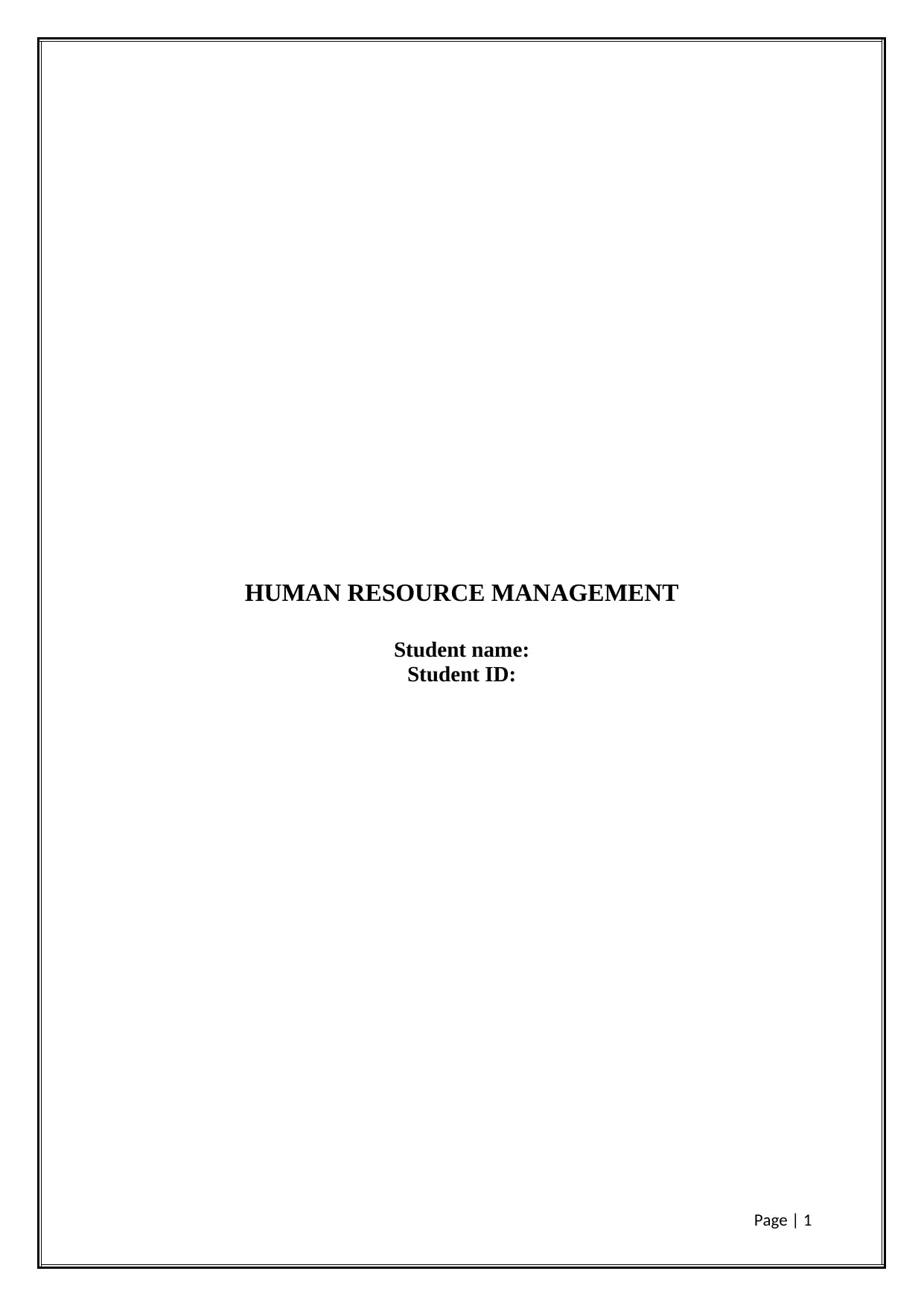
HUMAN RESOURCE MANAGEMENT
Student name:
Student ID:
Page | 1
Student name:
Student ID:
Page | 1
Paraphrase This Document
Need a fresh take? Get an instant paraphrase of this document with our AI Paraphraser
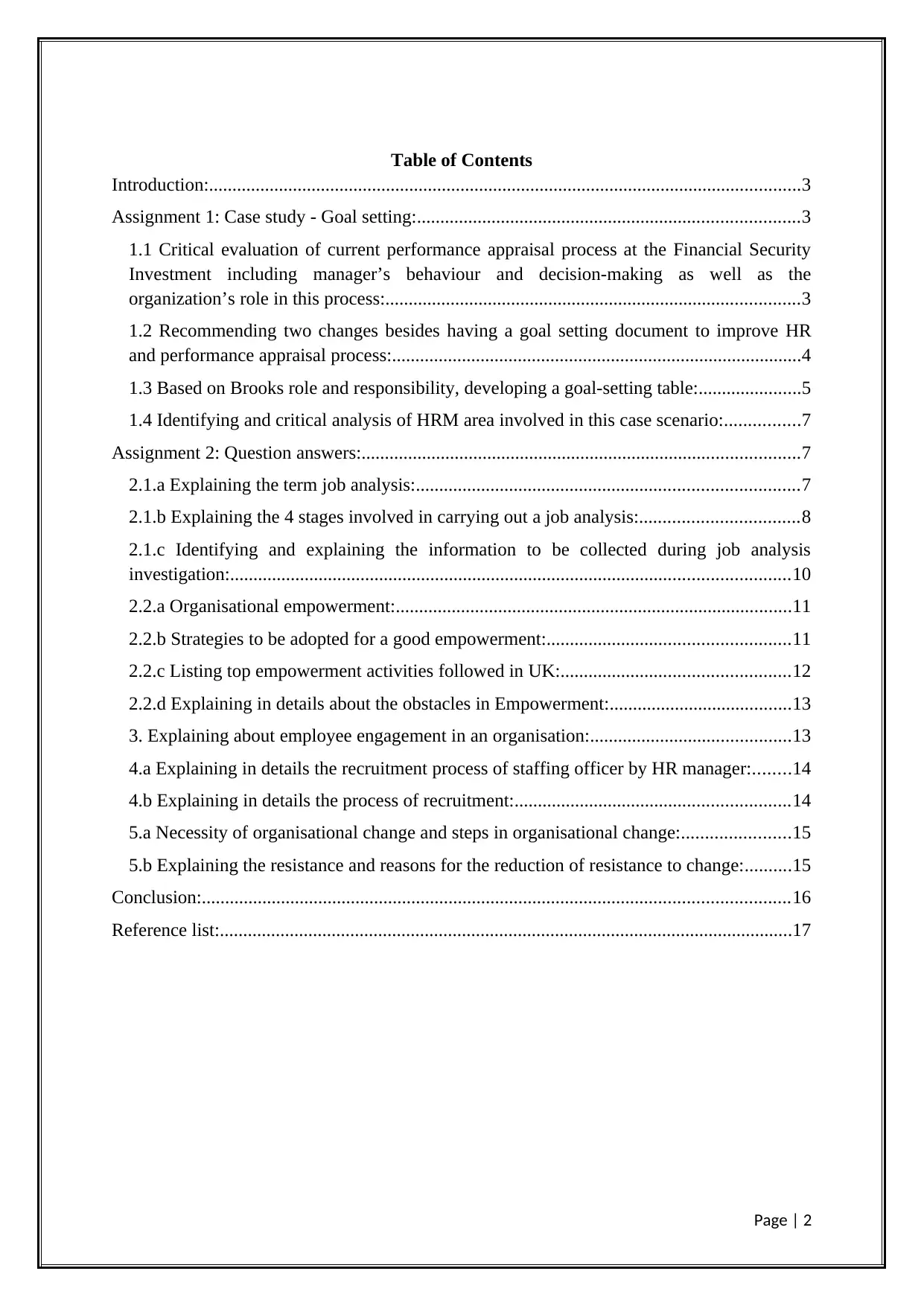
Table of Contents
Introduction:...............................................................................................................................3
Assignment 1: Case study - Goal setting:..................................................................................3
1.1 Critical evaluation of current performance appraisal process at the Financial Security
Investment including manager’s behaviour and decision-making as well as the
organization’s role in this process:.........................................................................................3
1.2 Recommending two changes besides having a goal setting document to improve HR
and performance appraisal process:........................................................................................4
1.3 Based on Brooks role and responsibility, developing a goal-setting table:......................5
1.4 Identifying and critical analysis of HRM area involved in this case scenario:................7
Assignment 2: Question answers:..............................................................................................7
2.1.a Explaining the term job analysis:..................................................................................7
2.1.b Explaining the 4 stages involved in carrying out a job analysis:..................................8
2.1.c Identifying and explaining the information to be collected during job analysis
investigation:........................................................................................................................10
2.2.a Organisational empowerment:.....................................................................................11
2.2.b Strategies to be adopted for a good empowerment:....................................................11
2.2.c Listing top empowerment activities followed in UK:.................................................12
2.2.d Explaining in details about the obstacles in Empowerment:.......................................13
3. Explaining about employee engagement in an organisation:...........................................13
4.a Explaining in details the recruitment process of staffing officer by HR manager:........14
4.b Explaining in details the process of recruitment:...........................................................14
5.a Necessity of organisational change and steps in organisational change:.......................15
5.b Explaining the resistance and reasons for the reduction of resistance to change:..........15
Conclusion:..............................................................................................................................16
Reference list:...........................................................................................................................17
Page | 2
Introduction:...............................................................................................................................3
Assignment 1: Case study - Goal setting:..................................................................................3
1.1 Critical evaluation of current performance appraisal process at the Financial Security
Investment including manager’s behaviour and decision-making as well as the
organization’s role in this process:.........................................................................................3
1.2 Recommending two changes besides having a goal setting document to improve HR
and performance appraisal process:........................................................................................4
1.3 Based on Brooks role and responsibility, developing a goal-setting table:......................5
1.4 Identifying and critical analysis of HRM area involved in this case scenario:................7
Assignment 2: Question answers:..............................................................................................7
2.1.a Explaining the term job analysis:..................................................................................7
2.1.b Explaining the 4 stages involved in carrying out a job analysis:..................................8
2.1.c Identifying and explaining the information to be collected during job analysis
investigation:........................................................................................................................10
2.2.a Organisational empowerment:.....................................................................................11
2.2.b Strategies to be adopted for a good empowerment:....................................................11
2.2.c Listing top empowerment activities followed in UK:.................................................12
2.2.d Explaining in details about the obstacles in Empowerment:.......................................13
3. Explaining about employee engagement in an organisation:...........................................13
4.a Explaining in details the recruitment process of staffing officer by HR manager:........14
4.b Explaining in details the process of recruitment:...........................................................14
5.a Necessity of organisational change and steps in organisational change:.......................15
5.b Explaining the resistance and reasons for the reduction of resistance to change:..........15
Conclusion:..............................................................................................................................16
Reference list:...........................................................................................................................17
Page | 2
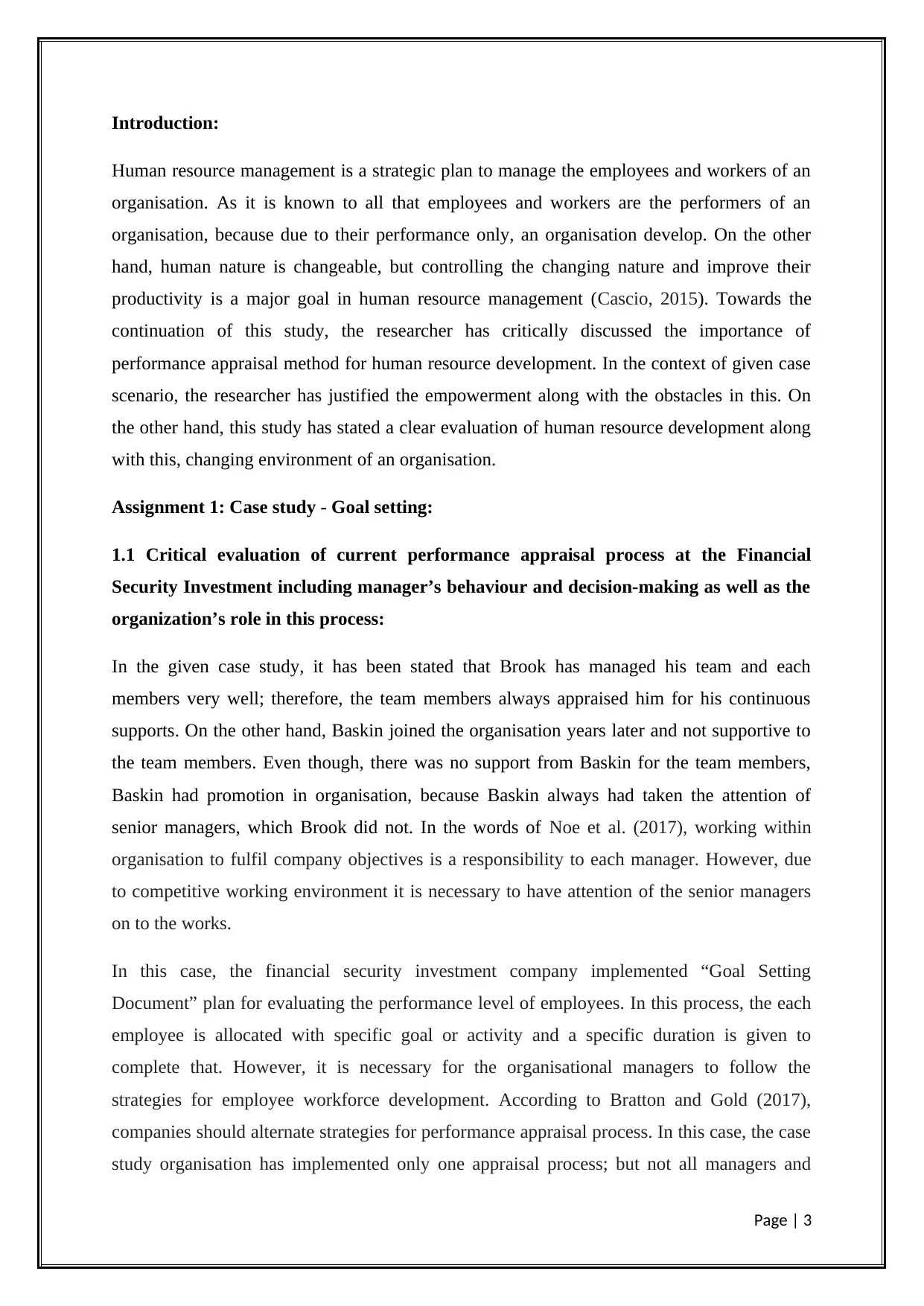
Introduction:
Human resource management is a strategic plan to manage the employees and workers of an
organisation. As it is known to all that employees and workers are the performers of an
organisation, because due to their performance only, an organisation develop. On the other
hand, human nature is changeable, but controlling the changing nature and improve their
productivity is a major goal in human resource management (Cascio, 2015). Towards the
continuation of this study, the researcher has critically discussed the importance of
performance appraisal method for human resource development. In the context of given case
scenario, the researcher has justified the empowerment along with the obstacles in this. On
the other hand, this study has stated a clear evaluation of human resource development along
with this, changing environment of an organisation.
Assignment 1: Case study - Goal setting:
1.1 Critical evaluation of current performance appraisal process at the Financial
Security Investment including manager’s behaviour and decision-making as well as the
organization’s role in this process:
In the given case study, it has been stated that Brook has managed his team and each
members very well; therefore, the team members always appraised him for his continuous
supports. On the other hand, Baskin joined the organisation years later and not supportive to
the team members. Even though, there was no support from Baskin for the team members,
Baskin had promotion in organisation, because Baskin always had taken the attention of
senior managers, which Brook did not. In the words of Noe et al. (2017), working within
organisation to fulfil company objectives is a responsibility to each manager. However, due
to competitive working environment it is necessary to have attention of the senior managers
on to the works.
In this case, the financial security investment company implemented “Goal Setting
Document” plan for evaluating the performance level of employees. In this process, the each
employee is allocated with specific goal or activity and a specific duration is given to
complete that. However, it is necessary for the organisational managers to follow the
strategies for employee workforce development. According to Bratton and Gold (2017),
companies should alternate strategies for performance appraisal process. In this case, the case
study organisation has implemented only one appraisal process; but not all managers and
Page | 3
Human resource management is a strategic plan to manage the employees and workers of an
organisation. As it is known to all that employees and workers are the performers of an
organisation, because due to their performance only, an organisation develop. On the other
hand, human nature is changeable, but controlling the changing nature and improve their
productivity is a major goal in human resource management (Cascio, 2015). Towards the
continuation of this study, the researcher has critically discussed the importance of
performance appraisal method for human resource development. In the context of given case
scenario, the researcher has justified the empowerment along with the obstacles in this. On
the other hand, this study has stated a clear evaluation of human resource development along
with this, changing environment of an organisation.
Assignment 1: Case study - Goal setting:
1.1 Critical evaluation of current performance appraisal process at the Financial
Security Investment including manager’s behaviour and decision-making as well as the
organization’s role in this process:
In the given case study, it has been stated that Brook has managed his team and each
members very well; therefore, the team members always appraised him for his continuous
supports. On the other hand, Baskin joined the organisation years later and not supportive to
the team members. Even though, there was no support from Baskin for the team members,
Baskin had promotion in organisation, because Baskin always had taken the attention of
senior managers, which Brook did not. In the words of Noe et al. (2017), working within
organisation to fulfil company objectives is a responsibility to each manager. However, due
to competitive working environment it is necessary to have attention of the senior managers
on to the works.
In this case, the financial security investment company implemented “Goal Setting
Document” plan for evaluating the performance level of employees. In this process, the each
employee is allocated with specific goal or activity and a specific duration is given to
complete that. However, it is necessary for the organisational managers to follow the
strategies for employee workforce development. According to Bratton and Gold (2017),
companies should alternate strategies for performance appraisal process. In this case, the case
study organisation has implemented only one appraisal process; but not all managers and
Page | 3
⊘ This is a preview!⊘
Do you want full access?
Subscribe today to unlock all pages.

Trusted by 1+ million students worldwide
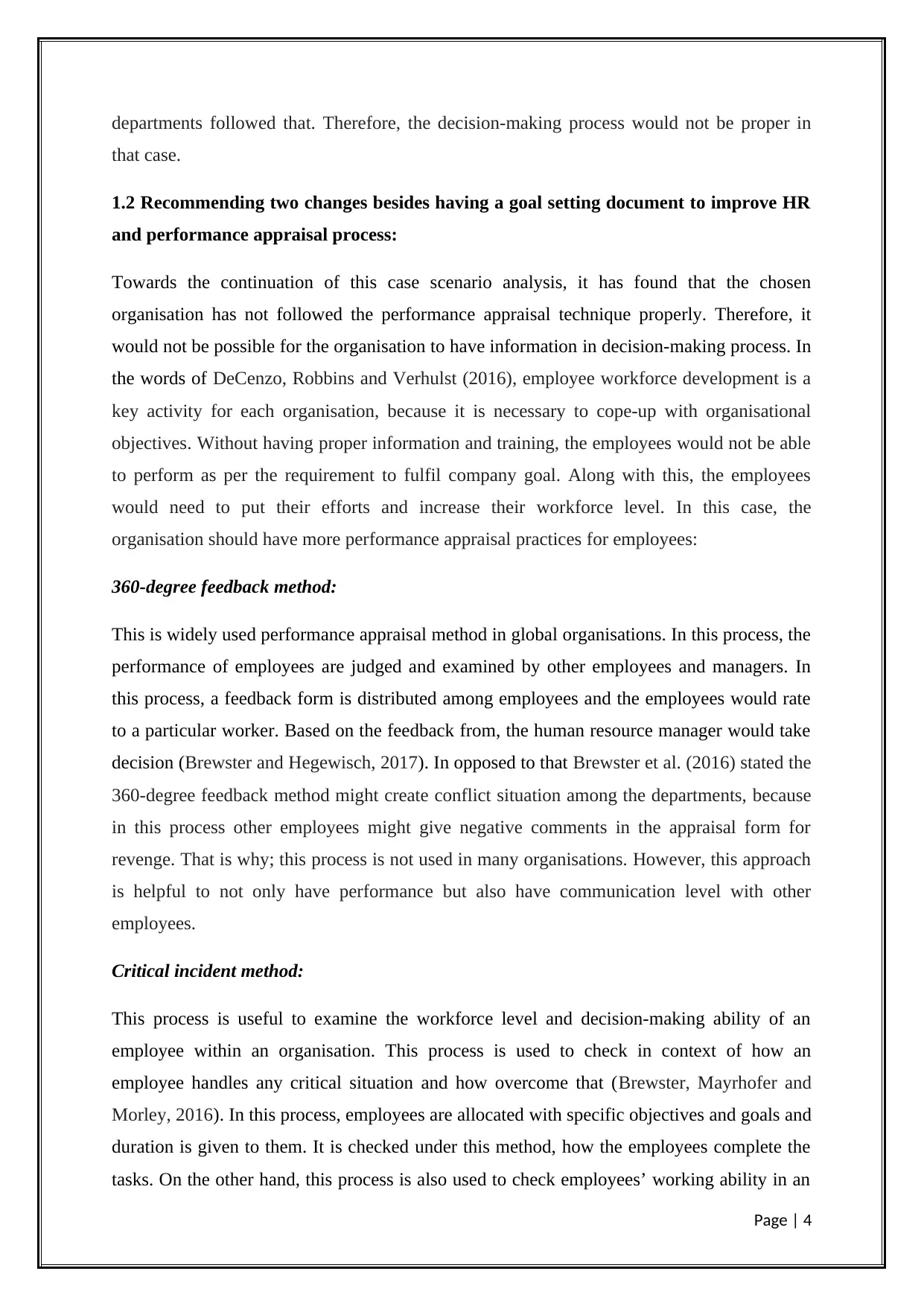
departments followed that. Therefore, the decision-making process would not be proper in
that case.
1.2 Recommending two changes besides having a goal setting document to improve HR
and performance appraisal process:
Towards the continuation of this case scenario analysis, it has found that the chosen
organisation has not followed the performance appraisal technique properly. Therefore, it
would not be possible for the organisation to have information in decision-making process. In
the words of DeCenzo, Robbins and Verhulst (2016), employee workforce development is a
key activity for each organisation, because it is necessary to cope-up with organisational
objectives. Without having proper information and training, the employees would not be able
to perform as per the requirement to fulfil company goal. Along with this, the employees
would need to put their efforts and increase their workforce level. In this case, the
organisation should have more performance appraisal practices for employees:
360-degree feedback method:
This is widely used performance appraisal method in global organisations. In this process, the
performance of employees are judged and examined by other employees and managers. In
this process, a feedback form is distributed among employees and the employees would rate
to a particular worker. Based on the feedback from, the human resource manager would take
decision (Brewster and Hegewisch, 2017). In opposed to that Brewster et al. (2016) stated the
360-degree feedback method might create conflict situation among the departments, because
in this process other employees might give negative comments in the appraisal form for
revenge. That is why; this process is not used in many organisations. However, this approach
is helpful to not only have performance but also have communication level with other
employees.
Critical incident method:
This process is useful to examine the workforce level and decision-making ability of an
employee within an organisation. This process is used to check in context of how an
employee handles any critical situation and how overcome that (Brewster, Mayrhofer and
Morley, 2016). In this process, employees are allocated with specific objectives and goals and
duration is given to them. It is checked under this method, how the employees complete the
tasks. On the other hand, this process is also used to check employees’ working ability in an
Page | 4
that case.
1.2 Recommending two changes besides having a goal setting document to improve HR
and performance appraisal process:
Towards the continuation of this case scenario analysis, it has found that the chosen
organisation has not followed the performance appraisal technique properly. Therefore, it
would not be possible for the organisation to have information in decision-making process. In
the words of DeCenzo, Robbins and Verhulst (2016), employee workforce development is a
key activity for each organisation, because it is necessary to cope-up with organisational
objectives. Without having proper information and training, the employees would not be able
to perform as per the requirement to fulfil company goal. Along with this, the employees
would need to put their efforts and increase their workforce level. In this case, the
organisation should have more performance appraisal practices for employees:
360-degree feedback method:
This is widely used performance appraisal method in global organisations. In this process, the
performance of employees are judged and examined by other employees and managers. In
this process, a feedback form is distributed among employees and the employees would rate
to a particular worker. Based on the feedback from, the human resource manager would take
decision (Brewster and Hegewisch, 2017). In opposed to that Brewster et al. (2016) stated the
360-degree feedback method might create conflict situation among the departments, because
in this process other employees might give negative comments in the appraisal form for
revenge. That is why; this process is not used in many organisations. However, this approach
is helpful to not only have performance but also have communication level with other
employees.
Critical incident method:
This process is useful to examine the workforce level and decision-making ability of an
employee within an organisation. This process is used to check in context of how an
employee handles any critical situation and how overcome that (Brewster, Mayrhofer and
Morley, 2016). In this process, employees are allocated with specific objectives and goals and
duration is given to them. It is checked under this method, how the employees complete the
tasks. On the other hand, this process is also used to check employees’ working ability in an
Page | 4
Paraphrase This Document
Need a fresh take? Get an instant paraphrase of this document with our AI Paraphraser
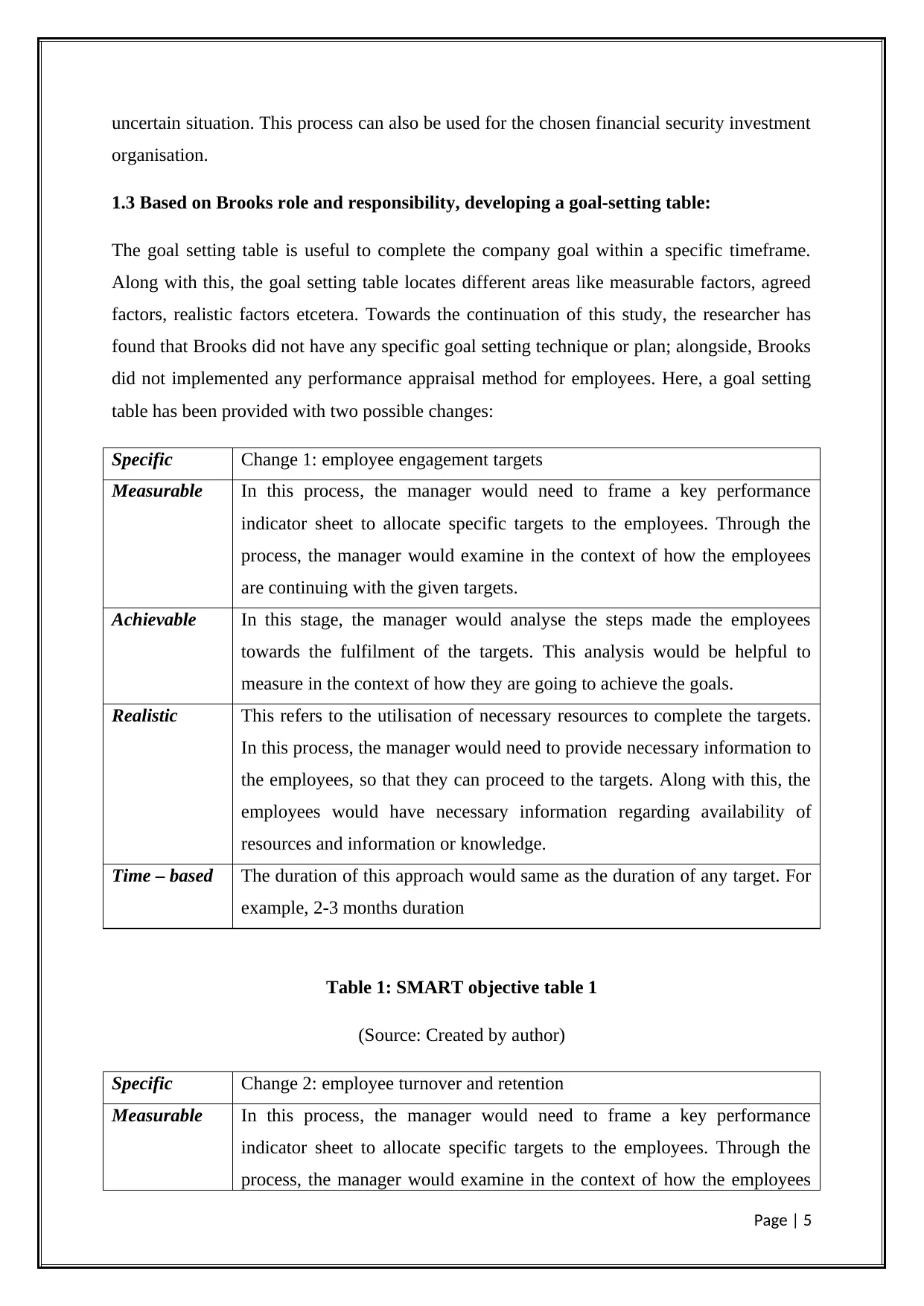
uncertain situation. This process can also be used for the chosen financial security investment
organisation.
1.3 Based on Brooks role and responsibility, developing a goal-setting table:
The goal setting table is useful to complete the company goal within a specific timeframe.
Along with this, the goal setting table locates different areas like measurable factors, agreed
factors, realistic factors etcetera. Towards the continuation of this study, the researcher has
found that Brooks did not have any specific goal setting technique or plan; alongside, Brooks
did not implemented any performance appraisal method for employees. Here, a goal setting
table has been provided with two possible changes:
Specific Change 1: employee engagement targets
Measurable In this process, the manager would need to frame a key performance
indicator sheet to allocate specific targets to the employees. Through the
process, the manager would examine in the context of how the employees
are continuing with the given targets.
Achievable In this stage, the manager would analyse the steps made the employees
towards the fulfilment of the targets. This analysis would be helpful to
measure in the context of how they are going to achieve the goals.
Realistic This refers to the utilisation of necessary resources to complete the targets.
In this process, the manager would need to provide necessary information to
the employees, so that they can proceed to the targets. Along with this, the
employees would have necessary information regarding availability of
resources and information or knowledge.
Time – based The duration of this approach would same as the duration of any target. For
example, 2-3 months duration
Table 1: SMART objective table 1
(Source: Created by author)
Specific Change 2: employee turnover and retention
Measurable In this process, the manager would need to frame a key performance
indicator sheet to allocate specific targets to the employees. Through the
process, the manager would examine in the context of how the employees
Page | 5
organisation.
1.3 Based on Brooks role and responsibility, developing a goal-setting table:
The goal setting table is useful to complete the company goal within a specific timeframe.
Along with this, the goal setting table locates different areas like measurable factors, agreed
factors, realistic factors etcetera. Towards the continuation of this study, the researcher has
found that Brooks did not have any specific goal setting technique or plan; alongside, Brooks
did not implemented any performance appraisal method for employees. Here, a goal setting
table has been provided with two possible changes:
Specific Change 1: employee engagement targets
Measurable In this process, the manager would need to frame a key performance
indicator sheet to allocate specific targets to the employees. Through the
process, the manager would examine in the context of how the employees
are continuing with the given targets.
Achievable In this stage, the manager would analyse the steps made the employees
towards the fulfilment of the targets. This analysis would be helpful to
measure in the context of how they are going to achieve the goals.
Realistic This refers to the utilisation of necessary resources to complete the targets.
In this process, the manager would need to provide necessary information to
the employees, so that they can proceed to the targets. Along with this, the
employees would have necessary information regarding availability of
resources and information or knowledge.
Time – based The duration of this approach would same as the duration of any target. For
example, 2-3 months duration
Table 1: SMART objective table 1
(Source: Created by author)
Specific Change 2: employee turnover and retention
Measurable In this process, the manager would need to frame a key performance
indicator sheet to allocate specific targets to the employees. Through the
process, the manager would examine in the context of how the employees
Page | 5
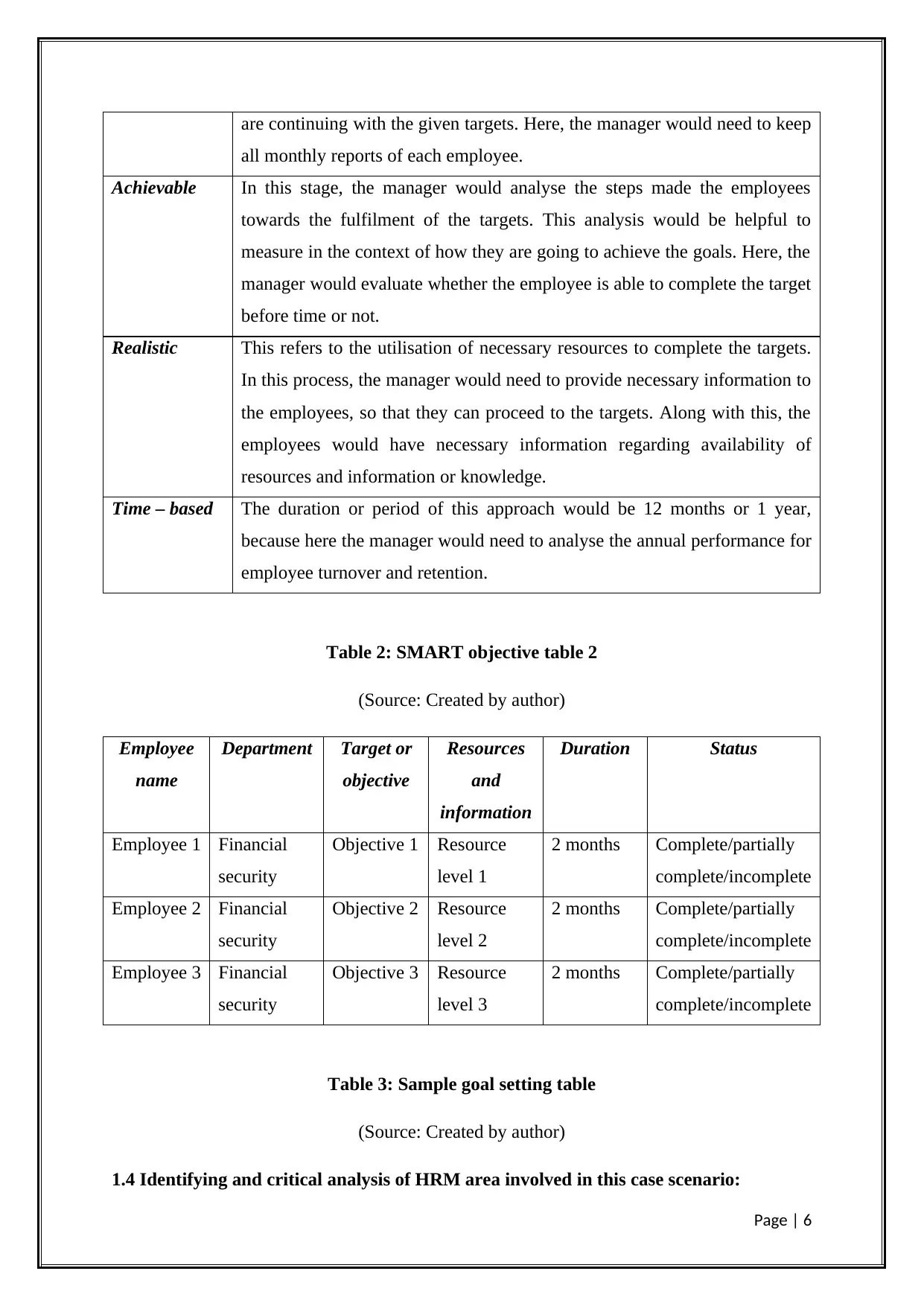
are continuing with the given targets. Here, the manager would need to keep
all monthly reports of each employee.
Achievable In this stage, the manager would analyse the steps made the employees
towards the fulfilment of the targets. This analysis would be helpful to
measure in the context of how they are going to achieve the goals. Here, the
manager would evaluate whether the employee is able to complete the target
before time or not.
Realistic This refers to the utilisation of necessary resources to complete the targets.
In this process, the manager would need to provide necessary information to
the employees, so that they can proceed to the targets. Along with this, the
employees would have necessary information regarding availability of
resources and information or knowledge.
Time – based The duration or period of this approach would be 12 months or 1 year,
because here the manager would need to analyse the annual performance for
employee turnover and retention.
Table 2: SMART objective table 2
(Source: Created by author)
Employee
name
Department Target or
objective
Resources
and
information
Duration Status
Employee 1 Financial
security
Objective 1 Resource
level 1
2 months Complete/partially
complete/incomplete
Employee 2 Financial
security
Objective 2 Resource
level 2
2 months Complete/partially
complete/incomplete
Employee 3 Financial
security
Objective 3 Resource
level 3
2 months Complete/partially
complete/incomplete
Table 3: Sample goal setting table
(Source: Created by author)
1.4 Identifying and critical analysis of HRM area involved in this case scenario:
Page | 6
all monthly reports of each employee.
Achievable In this stage, the manager would analyse the steps made the employees
towards the fulfilment of the targets. This analysis would be helpful to
measure in the context of how they are going to achieve the goals. Here, the
manager would evaluate whether the employee is able to complete the target
before time or not.
Realistic This refers to the utilisation of necessary resources to complete the targets.
In this process, the manager would need to provide necessary information to
the employees, so that they can proceed to the targets. Along with this, the
employees would have necessary information regarding availability of
resources and information or knowledge.
Time – based The duration or period of this approach would be 12 months or 1 year,
because here the manager would need to analyse the annual performance for
employee turnover and retention.
Table 2: SMART objective table 2
(Source: Created by author)
Employee
name
Department Target or
objective
Resources
and
information
Duration Status
Employee 1 Financial
security
Objective 1 Resource
level 1
2 months Complete/partially
complete/incomplete
Employee 2 Financial
security
Objective 2 Resource
level 2
2 months Complete/partially
complete/incomplete
Employee 3 Financial
security
Objective 3 Resource
level 3
2 months Complete/partially
complete/incomplete
Table 3: Sample goal setting table
(Source: Created by author)
1.4 Identifying and critical analysis of HRM area involved in this case scenario:
Page | 6
⊘ This is a preview!⊘
Do you want full access?
Subscribe today to unlock all pages.

Trusted by 1+ million students worldwide
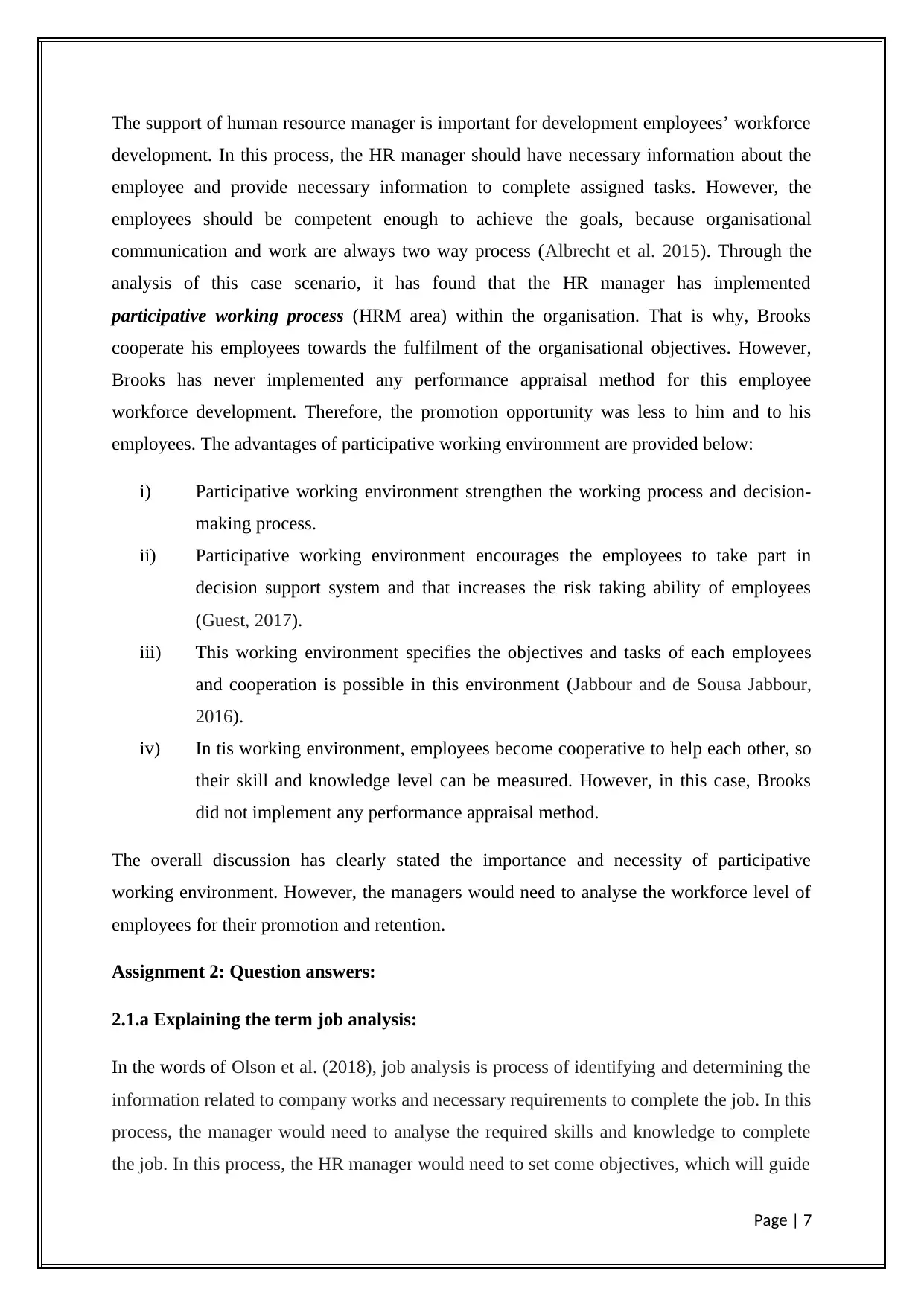
The support of human resource manager is important for development employees’ workforce
development. In this process, the HR manager should have necessary information about the
employee and provide necessary information to complete assigned tasks. However, the
employees should be competent enough to achieve the goals, because organisational
communication and work are always two way process (Albrecht et al. 2015). Through the
analysis of this case scenario, it has found that the HR manager has implemented
participative working process (HRM area) within the organisation. That is why, Brooks
cooperate his employees towards the fulfilment of the organisational objectives. However,
Brooks has never implemented any performance appraisal method for this employee
workforce development. Therefore, the promotion opportunity was less to him and to his
employees. The advantages of participative working environment are provided below:
i) Participative working environment strengthen the working process and decision-
making process.
ii) Participative working environment encourages the employees to take part in
decision support system and that increases the risk taking ability of employees
(Guest, 2017).
iii) This working environment specifies the objectives and tasks of each employees
and cooperation is possible in this environment (Jabbour and de Sousa Jabbour,
2016).
iv) In tis working environment, employees become cooperative to help each other, so
their skill and knowledge level can be measured. However, in this case, Brooks
did not implement any performance appraisal method.
The overall discussion has clearly stated the importance and necessity of participative
working environment. However, the managers would need to analyse the workforce level of
employees for their promotion and retention.
Assignment 2: Question answers:
2.1.a Explaining the term job analysis:
In the words of Olson et al. (2018), job analysis is process of identifying and determining the
information related to company works and necessary requirements to complete the job. In this
process, the manager would need to analyse the required skills and knowledge to complete
the job. In this process, the HR manager would need to set come objectives, which will guide
Page | 7
development. In this process, the HR manager should have necessary information about the
employee and provide necessary information to complete assigned tasks. However, the
employees should be competent enough to achieve the goals, because organisational
communication and work are always two way process (Albrecht et al. 2015). Through the
analysis of this case scenario, it has found that the HR manager has implemented
participative working process (HRM area) within the organisation. That is why, Brooks
cooperate his employees towards the fulfilment of the organisational objectives. However,
Brooks has never implemented any performance appraisal method for this employee
workforce development. Therefore, the promotion opportunity was less to him and to his
employees. The advantages of participative working environment are provided below:
i) Participative working environment strengthen the working process and decision-
making process.
ii) Participative working environment encourages the employees to take part in
decision support system and that increases the risk taking ability of employees
(Guest, 2017).
iii) This working environment specifies the objectives and tasks of each employees
and cooperation is possible in this environment (Jabbour and de Sousa Jabbour,
2016).
iv) In tis working environment, employees become cooperative to help each other, so
their skill and knowledge level can be measured. However, in this case, Brooks
did not implement any performance appraisal method.
The overall discussion has clearly stated the importance and necessity of participative
working environment. However, the managers would need to analyse the workforce level of
employees for their promotion and retention.
Assignment 2: Question answers:
2.1.a Explaining the term job analysis:
In the words of Olson et al. (2018), job analysis is process of identifying and determining the
information related to company works and necessary requirements to complete the job. In this
process, the manager would need to analyse the required skills and knowledge to complete
the job. In this process, the HR manager would need to set come objectives, which will guide
Page | 7
Paraphrase This Document
Need a fresh take? Get an instant paraphrase of this document with our AI Paraphraser
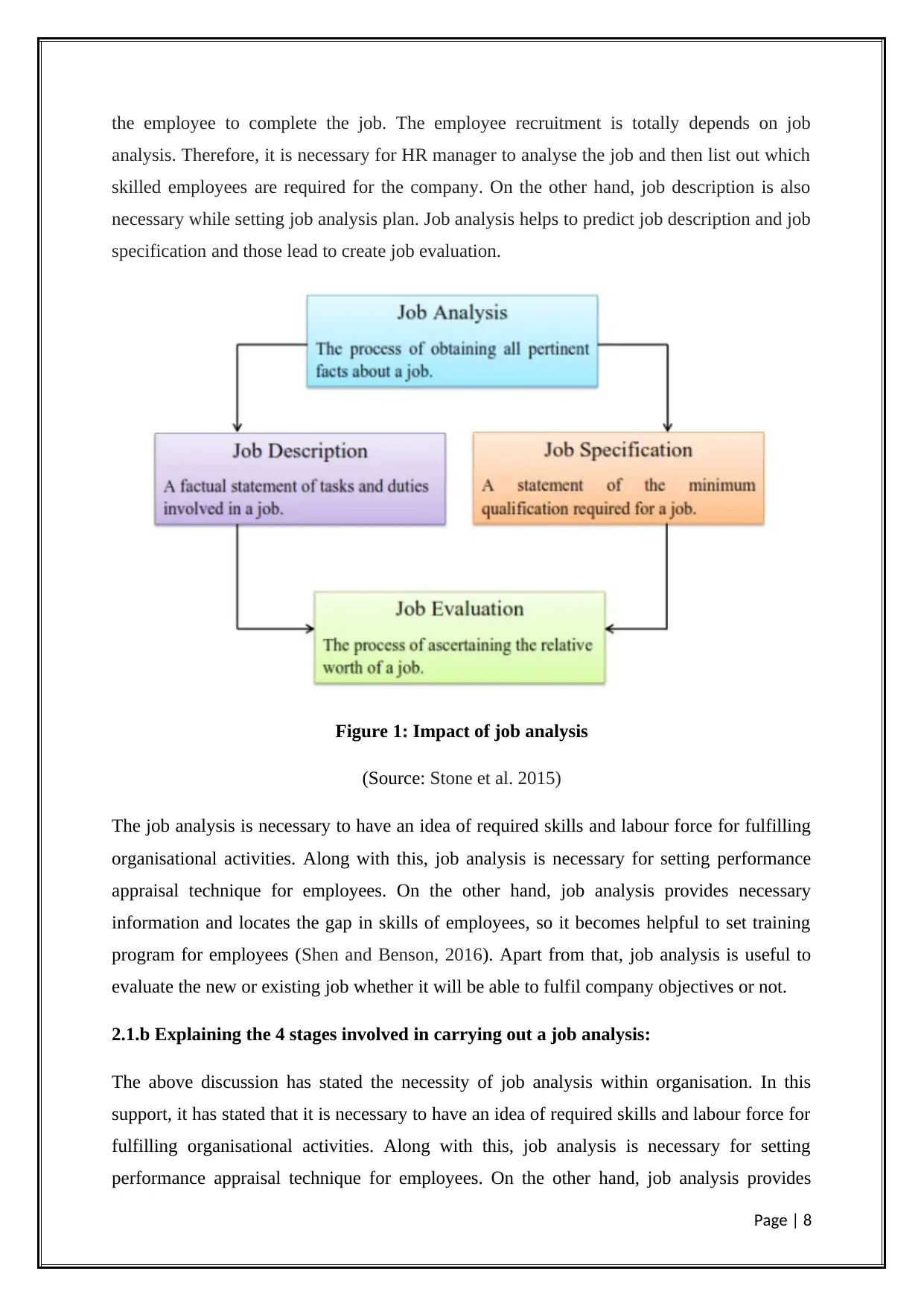
the employee to complete the job. The employee recruitment is totally depends on job
analysis. Therefore, it is necessary for HR manager to analyse the job and then list out which
skilled employees are required for the company. On the other hand, job description is also
necessary while setting job analysis plan. Job analysis helps to predict job description and job
specification and those lead to create job evaluation.
Figure 1: Impact of job analysis
(Source: Stone et al. 2015)
The job analysis is necessary to have an idea of required skills and labour force for fulfilling
organisational activities. Along with this, job analysis is necessary for setting performance
appraisal technique for employees. On the other hand, job analysis provides necessary
information and locates the gap in skills of employees, so it becomes helpful to set training
program for employees (Shen and Benson, 2016). Apart from that, job analysis is useful to
evaluate the new or existing job whether it will be able to fulfil company objectives or not.
2.1.b Explaining the 4 stages involved in carrying out a job analysis:
The above discussion has stated the necessity of job analysis within organisation. In this
support, it has stated that it is necessary to have an idea of required skills and labour force for
fulfilling organisational activities. Along with this, job analysis is necessary for setting
performance appraisal technique for employees. On the other hand, job analysis provides
Page | 8
analysis. Therefore, it is necessary for HR manager to analyse the job and then list out which
skilled employees are required for the company. On the other hand, job description is also
necessary while setting job analysis plan. Job analysis helps to predict job description and job
specification and those lead to create job evaluation.
Figure 1: Impact of job analysis
(Source: Stone et al. 2015)
The job analysis is necessary to have an idea of required skills and labour force for fulfilling
organisational activities. Along with this, job analysis is necessary for setting performance
appraisal technique for employees. On the other hand, job analysis provides necessary
information and locates the gap in skills of employees, so it becomes helpful to set training
program for employees (Shen and Benson, 2016). Apart from that, job analysis is useful to
evaluate the new or existing job whether it will be able to fulfil company objectives or not.
2.1.b Explaining the 4 stages involved in carrying out a job analysis:
The above discussion has stated the necessity of job analysis within organisation. In this
support, it has stated that it is necessary to have an idea of required skills and labour force for
fulfilling organisational activities. Along with this, job analysis is necessary for setting
performance appraisal technique for employees. On the other hand, job analysis provides
Page | 8
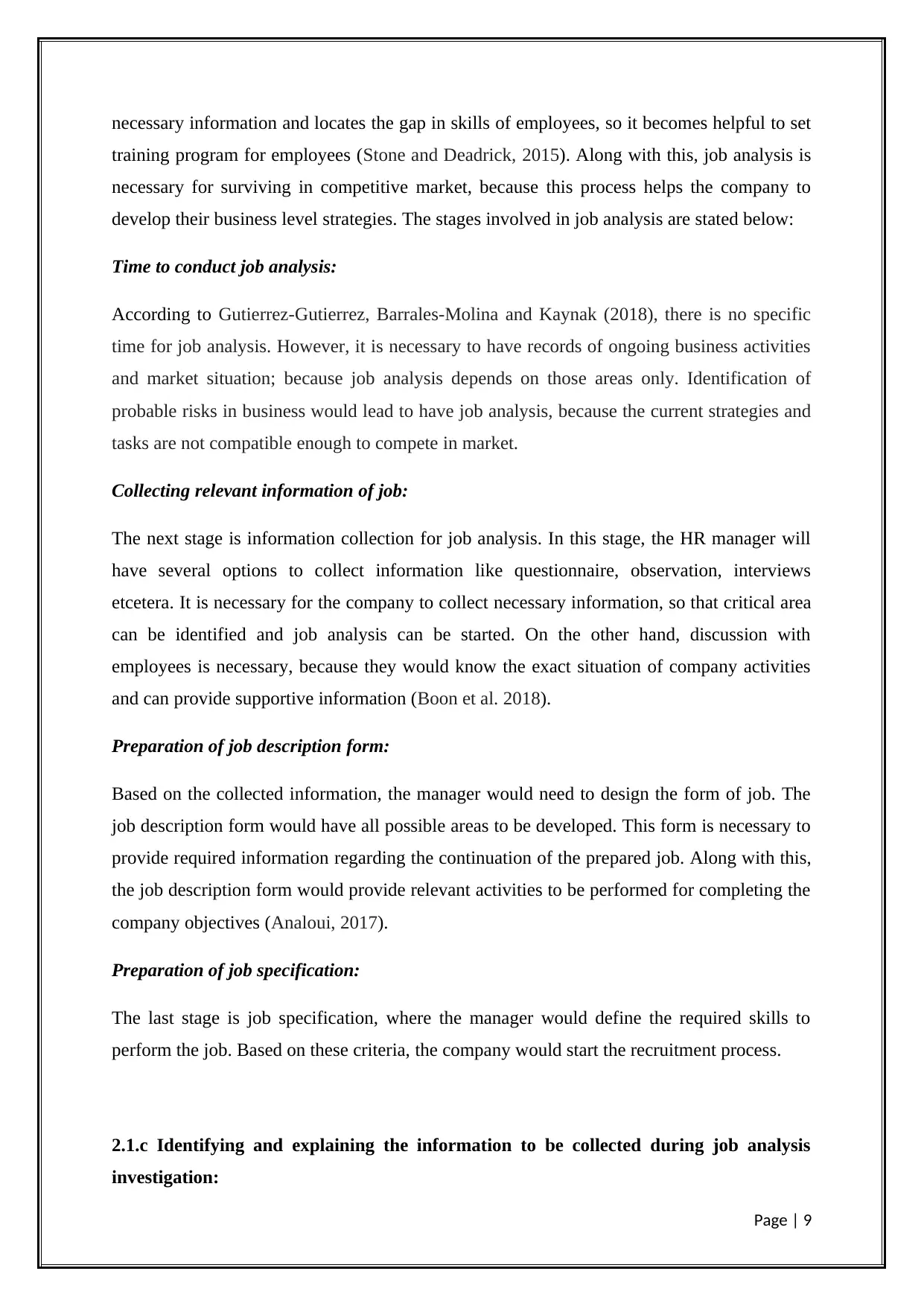
necessary information and locates the gap in skills of employees, so it becomes helpful to set
training program for employees (Stone and Deadrick, 2015). Along with this, job analysis is
necessary for surviving in competitive market, because this process helps the company to
develop their business level strategies. The stages involved in job analysis are stated below:
Time to conduct job analysis:
According to Gutierrez-Gutierrez, Barrales-Molina and Kaynak (2018), there is no specific
time for job analysis. However, it is necessary to have records of ongoing business activities
and market situation; because job analysis depends on those areas only. Identification of
probable risks in business would lead to have job analysis, because the current strategies and
tasks are not compatible enough to compete in market.
Collecting relevant information of job:
The next stage is information collection for job analysis. In this stage, the HR manager will
have several options to collect information like questionnaire, observation, interviews
etcetera. It is necessary for the company to collect necessary information, so that critical area
can be identified and job analysis can be started. On the other hand, discussion with
employees is necessary, because they would know the exact situation of company activities
and can provide supportive information (Boon et al. 2018).
Preparation of job description form:
Based on the collected information, the manager would need to design the form of job. The
job description form would have all possible areas to be developed. This form is necessary to
provide required information regarding the continuation of the prepared job. Along with this,
the job description form would provide relevant activities to be performed for completing the
company objectives (Analoui, 2017).
Preparation of job specification:
The last stage is job specification, where the manager would define the required skills to
perform the job. Based on these criteria, the company would start the recruitment process.
2.1.c Identifying and explaining the information to be collected during job analysis
investigation:
Page | 9
training program for employees (Stone and Deadrick, 2015). Along with this, job analysis is
necessary for surviving in competitive market, because this process helps the company to
develop their business level strategies. The stages involved in job analysis are stated below:
Time to conduct job analysis:
According to Gutierrez-Gutierrez, Barrales-Molina and Kaynak (2018), there is no specific
time for job analysis. However, it is necessary to have records of ongoing business activities
and market situation; because job analysis depends on those areas only. Identification of
probable risks in business would lead to have job analysis, because the current strategies and
tasks are not compatible enough to compete in market.
Collecting relevant information of job:
The next stage is information collection for job analysis. In this stage, the HR manager will
have several options to collect information like questionnaire, observation, interviews
etcetera. It is necessary for the company to collect necessary information, so that critical area
can be identified and job analysis can be started. On the other hand, discussion with
employees is necessary, because they would know the exact situation of company activities
and can provide supportive information (Boon et al. 2018).
Preparation of job description form:
Based on the collected information, the manager would need to design the form of job. The
job description form would have all possible areas to be developed. This form is necessary to
provide required information regarding the continuation of the prepared job. Along with this,
the job description form would provide relevant activities to be performed for completing the
company objectives (Analoui, 2017).
Preparation of job specification:
The last stage is job specification, where the manager would define the required skills to
perform the job. Based on these criteria, the company would start the recruitment process.
2.1.c Identifying and explaining the information to be collected during job analysis
investigation:
Page | 9
⊘ This is a preview!⊘
Do you want full access?
Subscribe today to unlock all pages.

Trusted by 1+ million students worldwide
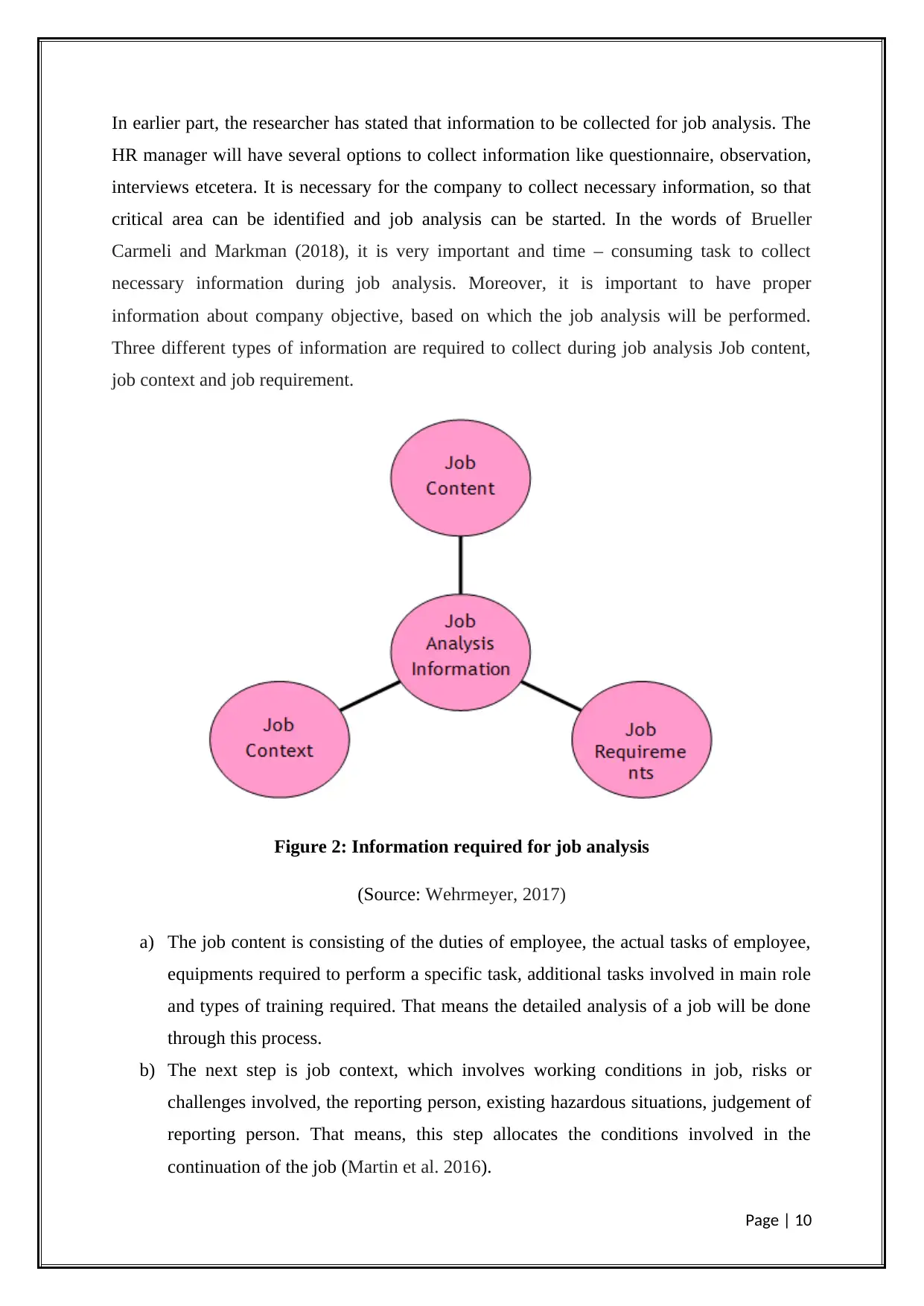
In earlier part, the researcher has stated that information to be collected for job analysis. The
HR manager will have several options to collect information like questionnaire, observation,
interviews etcetera. It is necessary for the company to collect necessary information, so that
critical area can be identified and job analysis can be started. In the words of Brueller
Carmeli and Markman (2018), it is very important and time – consuming task to collect
necessary information during job analysis. Moreover, it is important to have proper
information about company objective, based on which the job analysis will be performed.
Three different types of information are required to collect during job analysis Job content,
job context and job requirement.
Figure 2: Information required for job analysis
(Source: Wehrmeyer, 2017)
a) The job content is consisting of the duties of employee, the actual tasks of employee,
equipments required to perform a specific task, additional tasks involved in main role
and types of training required. That means the detailed analysis of a job will be done
through this process.
b) The next step is job context, which involves working conditions in job, risks or
challenges involved, the reporting person, existing hazardous situations, judgement of
reporting person. That means, this step allocates the conditions involved in the
continuation of the job (Martin et al. 2016).
Page | 10
HR manager will have several options to collect information like questionnaire, observation,
interviews etcetera. It is necessary for the company to collect necessary information, so that
critical area can be identified and job analysis can be started. In the words of Brueller
Carmeli and Markman (2018), it is very important and time – consuming task to collect
necessary information during job analysis. Moreover, it is important to have proper
information about company objective, based on which the job analysis will be performed.
Three different types of information are required to collect during job analysis Job content,
job context and job requirement.
Figure 2: Information required for job analysis
(Source: Wehrmeyer, 2017)
a) The job content is consisting of the duties of employee, the actual tasks of employee,
equipments required to perform a specific task, additional tasks involved in main role
and types of training required. That means the detailed analysis of a job will be done
through this process.
b) The next step is job context, which involves working conditions in job, risks or
challenges involved, the reporting person, existing hazardous situations, judgement of
reporting person. That means, this step allocates the conditions involved in the
continuation of the job (Martin et al. 2016).
Page | 10
Paraphrase This Document
Need a fresh take? Get an instant paraphrase of this document with our AI Paraphraser
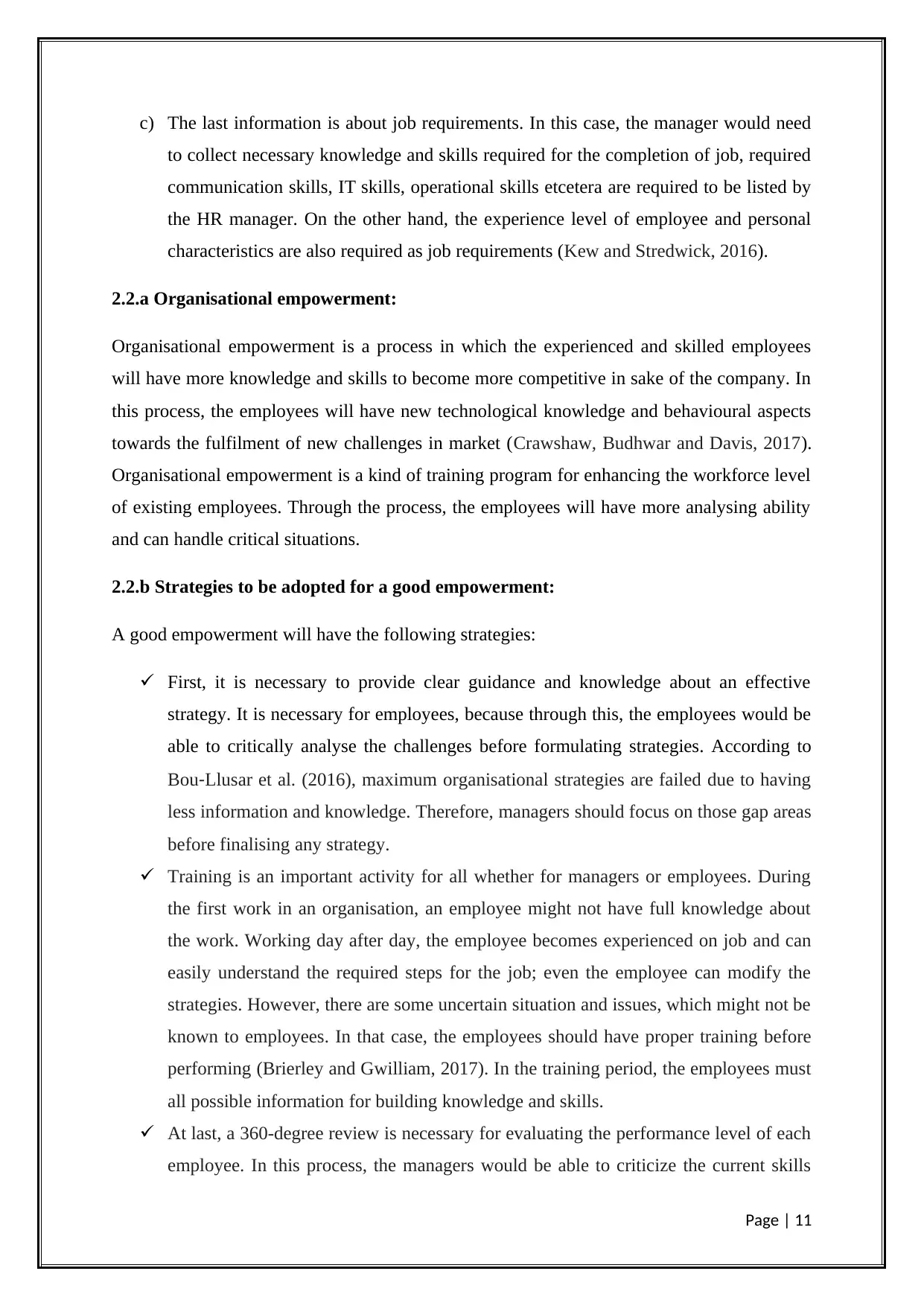
c) The last information is about job requirements. In this case, the manager would need
to collect necessary knowledge and skills required for the completion of job, required
communication skills, IT skills, operational skills etcetera are required to be listed by
the HR manager. On the other hand, the experience level of employee and personal
characteristics are also required as job requirements (Kew and Stredwick, 2016).
2.2.a Organisational empowerment:
Organisational empowerment is a process in which the experienced and skilled employees
will have more knowledge and skills to become more competitive in sake of the company. In
this process, the employees will have new technological knowledge and behavioural aspects
towards the fulfilment of new challenges in market (Crawshaw, Budhwar and Davis, 2017).
Organisational empowerment is a kind of training program for enhancing the workforce level
of existing employees. Through the process, the employees will have more analysing ability
and can handle critical situations.
2.2.b Strategies to be adopted for a good empowerment:
A good empowerment will have the following strategies:
First, it is necessary to provide clear guidance and knowledge about an effective
strategy. It is necessary for employees, because through this, the employees would be
able to critically analyse the challenges before formulating strategies. According to
Bou‐Llusar et al. (2016), maximum organisational strategies are failed due to having
less information and knowledge. Therefore, managers should focus on those gap areas
before finalising any strategy.
Training is an important activity for all whether for managers or employees. During
the first work in an organisation, an employee might not have full knowledge about
the work. Working day after day, the employee becomes experienced on job and can
easily understand the required steps for the job; even the employee can modify the
strategies. However, there are some uncertain situation and issues, which might not be
known to employees. In that case, the employees should have proper training before
performing (Brierley and Gwilliam, 2017). In the training period, the employees must
all possible information for building knowledge and skills.
At last, a 360-degree review is necessary for evaluating the performance level of each
employee. In this process, the managers would be able to criticize the current skills
Page | 11
to collect necessary knowledge and skills required for the completion of job, required
communication skills, IT skills, operational skills etcetera are required to be listed by
the HR manager. On the other hand, the experience level of employee and personal
characteristics are also required as job requirements (Kew and Stredwick, 2016).
2.2.a Organisational empowerment:
Organisational empowerment is a process in which the experienced and skilled employees
will have more knowledge and skills to become more competitive in sake of the company. In
this process, the employees will have new technological knowledge and behavioural aspects
towards the fulfilment of new challenges in market (Crawshaw, Budhwar and Davis, 2017).
Organisational empowerment is a kind of training program for enhancing the workforce level
of existing employees. Through the process, the employees will have more analysing ability
and can handle critical situations.
2.2.b Strategies to be adopted for a good empowerment:
A good empowerment will have the following strategies:
First, it is necessary to provide clear guidance and knowledge about an effective
strategy. It is necessary for employees, because through this, the employees would be
able to critically analyse the challenges before formulating strategies. According to
Bou‐Llusar et al. (2016), maximum organisational strategies are failed due to having
less information and knowledge. Therefore, managers should focus on those gap areas
before finalising any strategy.
Training is an important activity for all whether for managers or employees. During
the first work in an organisation, an employee might not have full knowledge about
the work. Working day after day, the employee becomes experienced on job and can
easily understand the required steps for the job; even the employee can modify the
strategies. However, there are some uncertain situation and issues, which might not be
known to employees. In that case, the employees should have proper training before
performing (Brierley and Gwilliam, 2017). In the training period, the employees must
all possible information for building knowledge and skills.
At last, a 360-degree review is necessary for evaluating the performance level of each
employee. In this process, the managers would be able to criticize the current skills
Page | 11
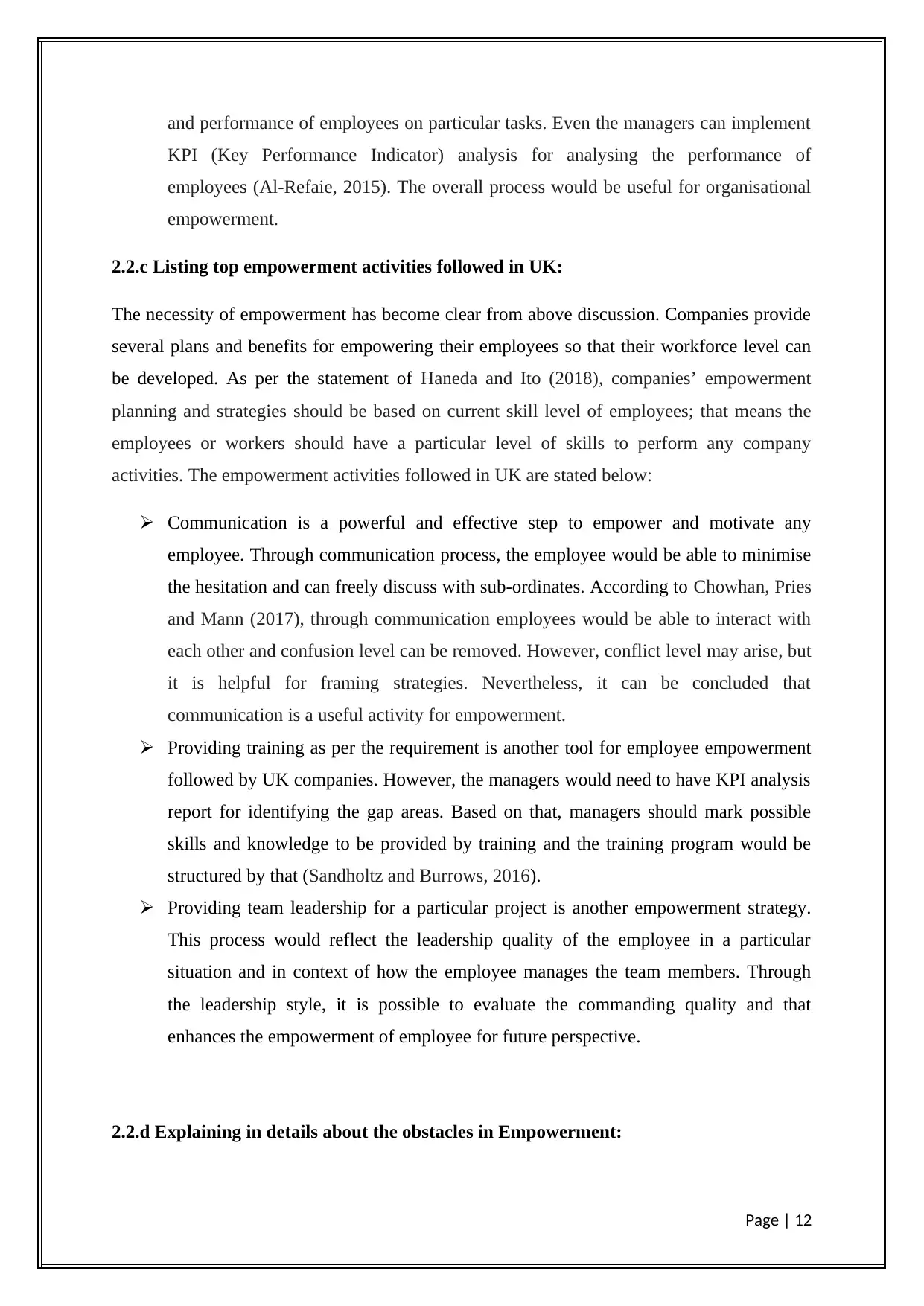
and performance of employees on particular tasks. Even the managers can implement
KPI (Key Performance Indicator) analysis for analysing the performance of
employees (Al-Refaie, 2015). The overall process would be useful for organisational
empowerment.
2.2.c Listing top empowerment activities followed in UK:
The necessity of empowerment has become clear from above discussion. Companies provide
several plans and benefits for empowering their employees so that their workforce level can
be developed. As per the statement of Haneda and Ito (2018), companies’ empowerment
planning and strategies should be based on current skill level of employees; that means the
employees or workers should have a particular level of skills to perform any company
activities. The empowerment activities followed in UK are stated below:
Communication is a powerful and effective step to empower and motivate any
employee. Through communication process, the employee would be able to minimise
the hesitation and can freely discuss with sub-ordinates. According to Chowhan, Pries
and Mann (2017), through communication employees would be able to interact with
each other and confusion level can be removed. However, conflict level may arise, but
it is helpful for framing strategies. Nevertheless, it can be concluded that
communication is a useful activity for empowerment.
Providing training as per the requirement is another tool for employee empowerment
followed by UK companies. However, the managers would need to have KPI analysis
report for identifying the gap areas. Based on that, managers should mark possible
skills and knowledge to be provided by training and the training program would be
structured by that (Sandholtz and Burrows, 2016).
Providing team leadership for a particular project is another empowerment strategy.
This process would reflect the leadership quality of the employee in a particular
situation and in context of how the employee manages the team members. Through
the leadership style, it is possible to evaluate the commanding quality and that
enhances the empowerment of employee for future perspective.
2.2.d Explaining in details about the obstacles in Empowerment:
Page | 12
KPI (Key Performance Indicator) analysis for analysing the performance of
employees (Al-Refaie, 2015). The overall process would be useful for organisational
empowerment.
2.2.c Listing top empowerment activities followed in UK:
The necessity of empowerment has become clear from above discussion. Companies provide
several plans and benefits for empowering their employees so that their workforce level can
be developed. As per the statement of Haneda and Ito (2018), companies’ empowerment
planning and strategies should be based on current skill level of employees; that means the
employees or workers should have a particular level of skills to perform any company
activities. The empowerment activities followed in UK are stated below:
Communication is a powerful and effective step to empower and motivate any
employee. Through communication process, the employee would be able to minimise
the hesitation and can freely discuss with sub-ordinates. According to Chowhan, Pries
and Mann (2017), through communication employees would be able to interact with
each other and confusion level can be removed. However, conflict level may arise, but
it is helpful for framing strategies. Nevertheless, it can be concluded that
communication is a useful activity for empowerment.
Providing training as per the requirement is another tool for employee empowerment
followed by UK companies. However, the managers would need to have KPI analysis
report for identifying the gap areas. Based on that, managers should mark possible
skills and knowledge to be provided by training and the training program would be
structured by that (Sandholtz and Burrows, 2016).
Providing team leadership for a particular project is another empowerment strategy.
This process would reflect the leadership quality of the employee in a particular
situation and in context of how the employee manages the team members. Through
the leadership style, it is possible to evaluate the commanding quality and that
enhances the empowerment of employee for future perspective.
2.2.d Explaining in details about the obstacles in Empowerment:
Page | 12
⊘ This is a preview!⊘
Do you want full access?
Subscribe today to unlock all pages.

Trusted by 1+ million students worldwide
1 out of 19
Related Documents
Your All-in-One AI-Powered Toolkit for Academic Success.
+13062052269
info@desklib.com
Available 24*7 on WhatsApp / Email
![[object Object]](/_next/static/media/star-bottom.7253800d.svg)
Unlock your academic potential
Copyright © 2020–2025 A2Z Services. All Rights Reserved. Developed and managed by ZUCOL.





